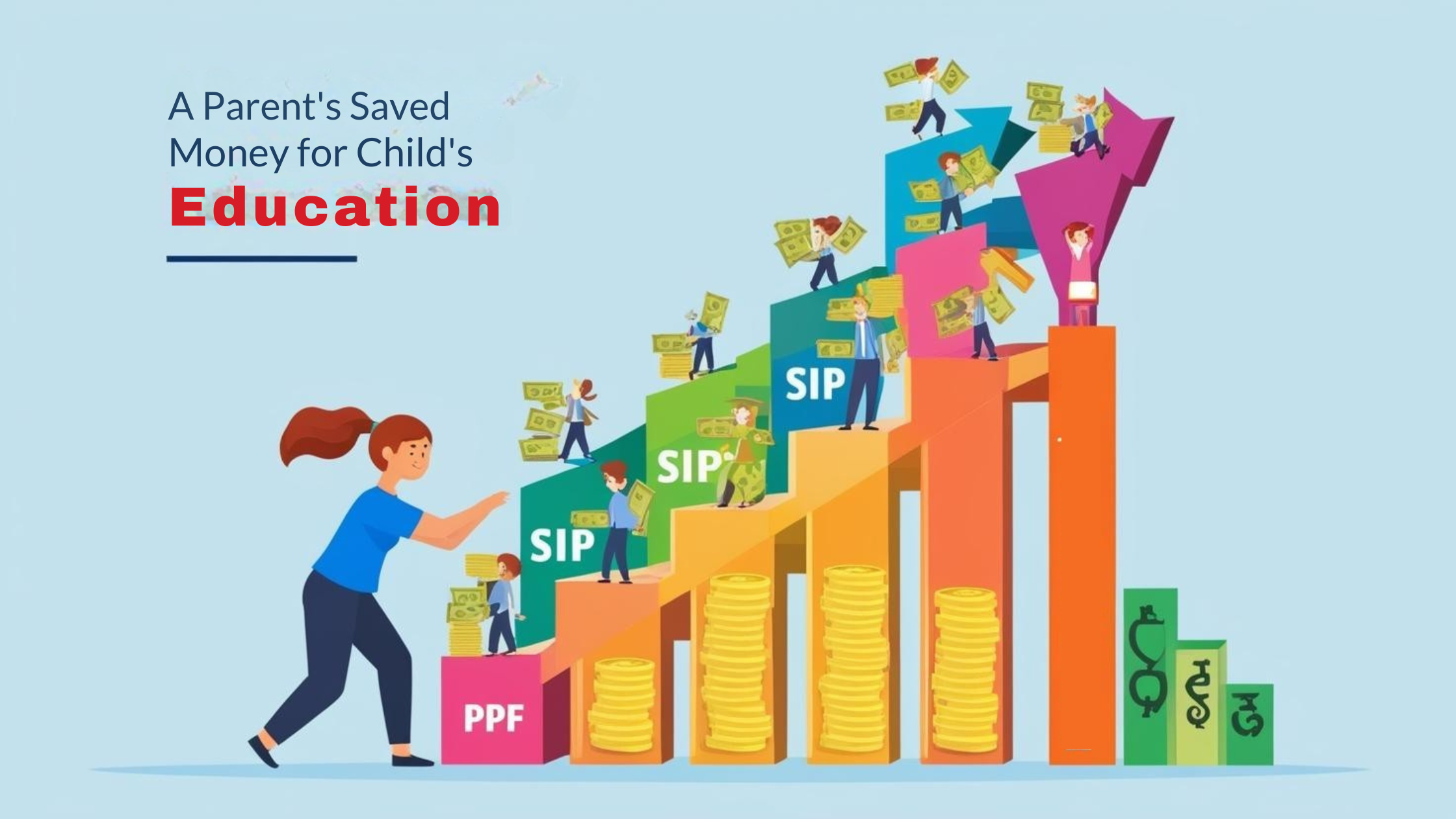
Every parent must have an education plan if they really want the best education for their child. But let’s face it, school fees in India are rising faster than petrol prices or anything else in the world! This is not fake. Across Bengaluru, Delhi, and Mumbai, school fees have jumped by 50–80% in just three years only. With education costs increasing day by day, planning early isn’t just smart but also it’s very much important.
This blog will guide you through a simple and easy yet practical 10-year financial planning education to secure your child’s school future without sacrificing your peace of mind. Let’s break it down step by step.
Saving Money for Kids: Start Small, Grow Big
You don’t need to be a financial expert or a CA to start saving for your own child’s future. All it takes is just a little planning and the willingness to begin. You can start with small amounts initially. Most Indian parents think that they’ll start "later" when they earn more. But trust us, starting early is more powerful than starting big.
Here’s how you start saving money for kids in a smart way:
1. Open a Dedicated Kids Savings Account
2. Start a Monthly SIP and Even Rs.500 is Enough
3. Use Any Cashback & Festival Gifts Wisely
4. Buy Smart, Save Smart
5. Encourage “Save Together
Why a 10-Year Plan Works Best

You know Education inflation in India grows at 6–10% every year. That means today’s ₹5 lakh annual school fee could reach upto ₹8–13 lakh in a decade! I guess you don't believe it but still you should know that starting early gives your money time to grow through compound interest (earning returns on your returns). Therefore it's the best plan. For example:
-
Saving ₹10,000/month for 10 years at 8% interest = ₹18.3 lakh
-
Waiting 5 years? You’d need ₹20,000/month to reach the same goal.
A 10-year horizon balances emergencies and flexibility also letting you adjust any fees or income change.
How to Estimate the Amount That Needs to Be Saved for Your Child’s Education Plan
-
Find Out Your Current School Fees:
You have to check the present annual fees of the schools you are interested in, including admission, tuition, books, and other expenses. This gives you a starting point for your calculations.
-
Consider Education Inflation:
School fees increase every year, usually by 6–10%. Use this rate to estimate how much the fees will be when your child starts school or moves to higher classes.
-
Note the Time Remaining for College Admission:
Calculate how many years are left until your child enters college. More time means more inflation and more time to save gradually.
-
Include All Other Related Expenses:
Don’t even forget to add other costs as well like uniforms, transport, extracurricular activities (if any), and exam fees. These small expenses can add up to a big amount over the coming years.
-
Account for Entrance Exam and Coaching Costs:
In India, entrance coaching fees for exams like NEET, JEE, CLAT, etc., can be expensive. Include these also in your total estimate.
-
Use Online Calculators:
Try free SIP or child education calculators which are available on financial websites. They make the calculation math easy and show you how much to save monthly.
-
Consider Scholarships or Government Schemes:
Look into some merit based scholarships and schemes like Sukanya Samriddhi Yojana or National Scholarship Portal to reduce the burden.
These steps will help you plan your savings in a systematic way, so you can secure your child’s education without stress!
How to Save Money for Kids: Step by Step Guide
Here is a simple step by step guidance tailored for you, so that you can have a simple idea on how to save money for kids. It will surely help you in future educational costs for your childrens. Check these steps before you start savings:
Step 1: Estimate Future School Costs

Start by researching current fees for schools which you’re targeting. For example:
-
Primary school (Class 1–5): ₹20,000–₹1.5 lakh/year
-
Middle school (Class 6–8): ₹1–₹2.5 lakh/year
-
High school (Class 9–12): ₹1.5–₹4 lakh/year
Now, factor in 8% annual inflation using this formula:
Future Cost = Current Cost × (1 + Inflation Rate)^Years
Example: If Class 1 fees today are ₹1.5 lakh:
-
Year 1: ₹1.5 lakh
-
Year 5: ₹1.5 lakh × (1.08)^5 = ₹2.2 lakh
-
Year 10: ₹1.5 lakh × (1.08)^10 = ₹3.24 lakh
Use this table to project costs:
|
School Level |
Current Cost (₹) |
Cost in 5 Years (₹) |
Cost in 10 Years (₹) |
|
Primary |
1,50,000 |
2,20,000 |
3,24,000 |
|
High School |
3,00,000 |
4,40,000 |
6,48,000 |
Step 2: Set Realistic Financial Savings Goals

Create an education savings account Once you’ve estimated future costs, calculate how much to save monthly. Let’s say you need ₹30 lakh in 10 years. Using an 8% return rate:
Monthly Investment = Goal / [(1 + Interest Rate/12)^(Years×12) – 1] × (Interest Rate/12)
Translation: Use a SIP calculator (easily available online) or follow this rough guide:
-
To save ₹30 lakh in 10 years at 8%: ≈ ₹16,500/month
Break it down into smaller goals:
|
Year |
Target Amount (₹) |
Monthly Savings (₹) |
|
1 |
2,00,000 |
15,000 |
|
5 |
12,00,000 |
18,000 |
|
10 |
30,00,000 |
20,000 |
Step 3: Investment options for childrens education

Not all investments are equal. Here’s a comparison of popular options and best way to save for education:
|
Option |
Returns (%) |
Risk |
Liquidity |
Tax Benefits? |
|
PPF |
7.1 |
Low |
Low |
Yes (80C) |
|
Mutual Funds (Equity) |
10–12 |
High |
Medium |
No |
|
Sukanya Samriddhi |
8.2 |
Low |
Low |
Yes (80C) |
|
Fixed Deposit |
6–7 |
Low |
Medium |
No |
For most families:
-
PPF is good for long-term saving, and Sukanya Samriddhi is best daughter investment plan to start with.
-
They also give tax benefits under Section 80C, helping you save more.
-
Add equity mutual funds for higher growth (ideal for 10-year goals). They may go up and down in the short term but usually grow more over time.
-
A mix of SIP in mutual funds and safe options gives better balance.
-
Fixed Deposits are safe but their returns are low, especially after tax.
Education costs rise faster than FD returns, so your money may lose value.
Step 4: Automate

Set up auto-debits from your salary account to investment accounts. This “pay yourself first” approach ensures you never miss a contribution. Apps like Groww or Coin by Zerodha make SIPs effortless. This method ensures you invest before spending, building financial discipline. For a 10-year goal like college fees, consistency is more important than the amount.
Benefits of Automated SIPs for Education Savings:
- Builds a regular saving habit without manual effort
- Ensures discipline and consistency over 10 years
- Frees you from tracking dates and worrying about market timing
Step 5: Review and Adjust Yearly
Life changes-so should your plan. Every Diwali, ask:
-
School fees have risen faster than expected? For instance, in cities like Bengaluru, fees have surged by 10% to 30% for the 2025–26 academic year, outpacing general inflation rates.
-
If you've received a salary hike or bonus, it's a good opportunity to increase your education savings. Even a 5% annual increment in savings can significantly impact the education fund over time.
-
Regularly review your investment portfolio to ensure it's aligned with your education savings goals. If certain investments aren't yielding expected returns, consider reallocating those funds to better performing assets. This strategy can enhance the growth of your child's education fund.
Step 6: Cut Costs Without Cutting Joy
Small changes add up:
-
Branded school uniforms can be expensive without offering extra value.Tailor-made uniforms look just as neat and cost a lot less by this way You’ll save money every year with this smart switch.
-
School transport charges can add up, especially for private vehicles or vans. Teaming up with nearby families to carpool is safe and economical.
-
Many textbooks are barely used and in great condition. You can buy them for half the price from seniors or parent WhatsApp groups. It’s a budget-friendly way to keep your child’s learning on track.
Step 7: Understand Tax slabs and use the benefits wisely
- Claim Tuition Fee Deduction Under Section 80C
- Invest in PPF (Public Provident Fund)
- Save in Sukanya Samriddhi Yojana (for a Girl Child)
- Invest in ELSS (Equity Linked Saving Scheme) Funds
Step 8: Involve Your Child
Teach money habits early and teach him about educational financial plan:
-
Give a ₹100/month allowance to manage.
-
Encourage saving 20% for a “want” (e.g., a bicycle).
Step 9: Explore Scholarships
Many schools offer merit or need-based aid. Apply early and keep documents ready:
-
Income certificates
-
Academic records
Step 10: Stay Consistent
Missed a month? Don’t panic. Restart next month. Remember, ₹500 saved today is ₹1,000 saved 5 years later!
Saving money for kids is very important as you know school fees are increasing in upcoming years. it’s about starting early, staying consistent, and choosing smart tools for savings. As the old Hindi saying goes, “Boond boond se sagar banta hai” (Every drop makes an ocean). Whether you save ₹5,000 or ₹50,000 monthly, what matters is taking that first step today for a child future.
Best Schools
- Best Schools in Hyderabad
- Best Schools in Bangalore
- Best Schools in Chennai
- Best Schools in Gurgaon
- Best Schools in Pune
- Best Schools in Kolkata
- Best Schools in Mumbai
- Best Schools in Jaipur
- Best Schools in Indore
- Best Schools in Thane
- Best Schools in Bhopal
- Best Schools in Nagpur
- Best Schools in Aurangabad
- Best Schools in Jodhpur
- Best Schools in Jabalpur
CBSE Schools
- CBSE Schools in Kolkata
- CBSE Schools in Chennai
- CBSE Schools in Hyderabad
- CBSE Schools in Bangalore
- CBSE Schools in Pune
- CBSE Schools in Mumbai
- CBSE Schools in Jaipur
- CBSE Schools in Nagpur
- CBSE Schools in Thane
- CBSE Schools in Aurangabad
- CBSE Schools in Jodhpur
- CBSE Schools in Indore
- CBSE Schools in Jabalpur
- CBSE Schools in Bhopal
- CBSE Schools in Gurgaon

Get In Touch
Your questions deserve expert answers Let's Talk
Need Help ?
Share your details, and we’ll reach out shortly.
